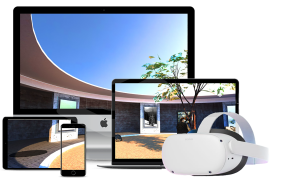Setting up a SAML2 IdP for Hyperspace Metaverse Platform with Okta
Jump to:
Setting up a SAML2 IdP for Hyperspace Metaverse Platform with Okta
1. Creating the SAML application
2. Configuring the application
3. Providing Hyperspace with authentication details
Overview
Okta is an Identity and Access Management (IAM) solution that enables associates from organizations to login to the Hyperspace Metaverse Platform using their existing organization credentials.
Given a simple link to a meeting, event, training or a corporate metaverse users can join frictionlessly through one login. Immersive experiences can now be woven into the flow of work without living in an “application silo”.
1. Creating the SAML application
Make sure you are logged into Okta, then select Applications > Applications in the left-hand menu.
In order to create a new App, click on Create App Integration.
In the sign-on method popup that appears, select SAML 2.0, then click Next.
2. Configuring the application
Fill in the App name field, then click Next.
2.1 General
The first section in the configuration is the General section. Some of the information required for these fields must be provided by Hyperspace, if you haven’t received it please reach out to your contact within Hyperspace or write to support.
Fill in the fields as follows:
- Single sign on URL: provided by Hyperspace, it will be similar to the following:
https://auth.universalavatars.com/saml2/<YOUR_SSO_ID>/acs - Use this for Recipient URL and Destination URL: checked
- Audience URI: provided by Hyperspace, it will be similar to the following: https://auth.universalavatars.com/saml2/<YOUR_SSO_ID>/metadata
- NameID format: Persistent
- Application username: Email
2.2 Attribute statements
Fill the Attribute statements section as follows. Please note the fields are case-sensitive.
Name | Name format | Value |
givenName | Basic | user.firstName |
sn | Basic | user.lastName |
Basic | user.email |
After adding the attribute statements, scroll to the bottom and click Next.
2.3 Feedback
The interface will now request some information about the integration, which isn’t required since the app is internal to your organization.
Choose “I’m an Okta customer” for the first question, and check “This is an internal app” for the second. Then click Finish.
3. Providing Hyperspace with authentication details
The last step in setting up the SSO integration is to provide Hyperspace with certain details of your application.
After creating the app, you will be brought back to its details page. Copy the link named Identity Provider metadata and supply it to Hyperspace (either by right-clicking on it and selecting “Copy Link Address”, or by opening it in a new tab and copying the URL).
Once setup has been completed on the Hyperspace side, you will be able to use this method to sign in on UniversalAvatars (and by extension the Hyperspace ecosystem).
Trademarks & Copyrights are property of their respective owners. Pictures are indicative only & may not reflect final production

